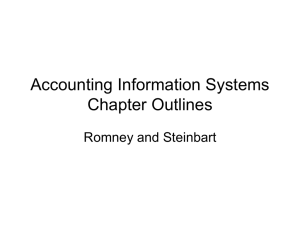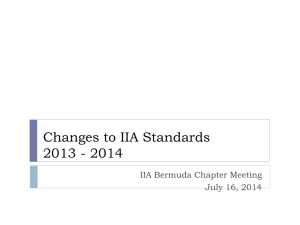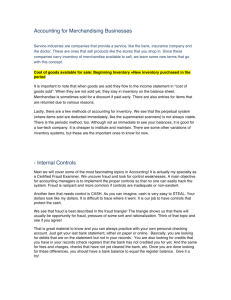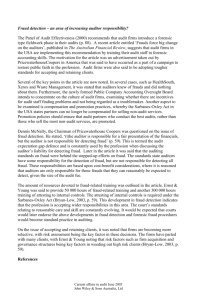Country Report Presentation
advertisement
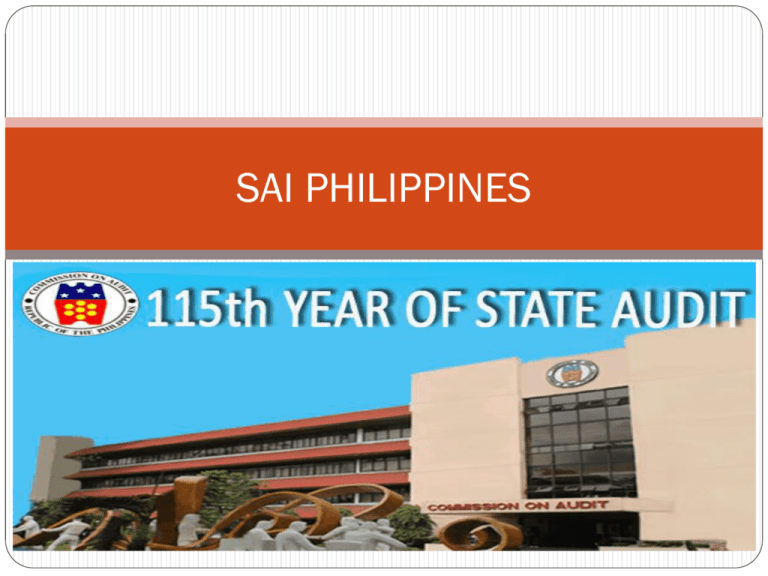
SAI PHILIPPINES Anti-corruption coordination between SAI and international organizations In 2012, the Philippine Government entered into an agreement with the International Bank for Reconstruction and Development of the World Bank for a grant aimed at further improving the effectiveness and efficiency of COA audit capabilities in financial, compliance, procurement, value-for-money and fraud audits through the development and adoption of a results-based integrated audit methodology using the Integrated Results and Risk-based Audit (IRRBA), The IRRBA and the Forensic Audit Manuals were developed as the primary guides of the audit sectors for the conducts of an integrated audit of agencies. The manuals contain the concepts, related International Standards of Auditing (ISAs) and International Standards of Audit for Supreme Audit Institutions (ISSAIs), relevant procedures, and documentation structure for the delivery of an integrated audit to auditees using the IRRBA. Anti-corruption coordination between SAI and international organizations Integrity for Investments Initiative (i3) - one of the USAID projects under the Partnership for Growth (PFG), a White House signature initiative that elevates bilateral engagement between the Government of the Philippines and the US Government to address the most serious constraints to economic growth and development in the Philippines. I3 will contribute to inclusive growth by reducing the costs of corruption to investments and trade, thereby promoting open and fair competition. The 5-year project commenced on 20 February 2013, with $14.7 million total estimated cost. The project will work with anticorruption offices, primarily the Office of the Ombudsman (OMB), Commission on Audit (COA), Civil Service Commission (CSC), Securities and Exchange Commission (SEC), and the Governance Commission for Government-Owned and Controlled Corporations (GOCCs). Anti-corruption coordination between SAI and international organizations The Philippines–Australia Public Financial Management Program (PFMP) is a long term partnership between the Governments of Australia and the Philippines to improve the efficiency, accountability and transparency of public fund use in the Philippines. The PFMP is assisting the Philippines Government to implement its Philippine PFM Reform Roadmap: Towards Improved Accountability and Transparency, 2011–2015. This comprehensive PFM reform agenda aims to clarify, simplify, improve and harmonize the financial management processes and information systems of the civil service in the Philippines. Improving anti-corruption measures in national level The Commission on Audit (COA), together with the Australian Government, launched the Disaster Risk Reduction and Management (DRRM) Accounting and Reporting Guidelines aim to further improve transparency and accountability in the use of disaster funds. “Benchmarked against the International Standards for Supreme Audit Institutions, these will ensure that all disaster-related funds and donations are properly accounted for and efficiently utilized. With the recent typhoons and other calamities, the Philippine government was faced with the challenge of protecting disaster aid funds without impeding response time and recovery assistance. In the case of Typhoon Yolanda (Haiyan), the public clamored for transparency on the use of government funds and other contributions from local and international donors. The use of the Disaster Accounting Guidelines will make the Filipino people confident on how disaster funds are allocated, utilized, and accounted for. Improving anti-corruption measures in national level The USAID-funded Philippines Integrity Project focuses on current successful anti-corruption initiatives while also establishing new initiatives to improve integrity within government agencies. It builds on work done from 2006 to 2009 by Management System International on the Millennium Challenge Account-Philippines Threshold Program Technical Assistance Project. More specifically, the Project has four components. MSI will assist the Office of the Ombudsman (OMB) in reengineering its business process in order to build better case records and information management capabilities and to improve capacity to use the Information Technology physical infrastructure now in place. Improving anti-corruption measures in national level MSI will also put in place a system to manage judicial court case evidence to support more successful prosecutions at all levels. MSI will work with the OMB and the Department of Justice (DOJ) to build an effective system for successful prosecution of lower court corruption cases. MSI will support completion and maintenance of an accurate database of cases to use as a tool for sound caseload management. It will also execute a Memorandum of Understanding between OMB and DOJ to support their collaboration on successful, timely prosecution, and training to make prosecutors more effective. Through a small grants program, civil society will conduct a court watch program. Improving anti-corruption measures in national level Initiatives in the fight against corruption will usually be most effective if they are carried out by concerned agencies cooperatively. MSI will provide specific targeted support for the strengthening of the cooperation between the OMB, the Commission on Audit (COA) and the Civil Service Commission (CSC). Support will focus on the more effective use of the Statement of Assets Liabilities and Net Worth and audits in prosecution of public officials for graft and corruption through joint training of auditors, investigators and prosecutors. Improving anti-corruption measures in national level Improvement of legal regulation in financial area – RA 9160, the Anti-Money Laundering Act of 2001 amended on 5 March 2003 (RA 9194). RA 9160 criminalized money laundering in the Philippines and, at the same time, introduced civil forfeiture as an appropriate remedy for the seizure and forfeiture in favour of the State, without the necessity of conviction or prosecution in a criminal case, of monetary instrument, property or proceeds involved in or related to an unlawful activity or money laundering offense as defined in the law. RA 9160 likewise created the Philippines Financial Intelligence Unit (FIU), the Anti-Money Laundering Council (AMLC) The COA is a principal of the Reform Program, along with the DBM, DOF and BTR. The PFM Reform Program of the government under the leadership of President Benigno Aquino III seeks to improve “efficiency, transparency and accountability in public fund use. Executive Order No. 55 signed on September 16, 2011 empowers the PFM Committee to implement the PFM Reform Roadmap,, an all-inclusive plan that will clarify, simplify, improve and harmonize the government’s financial management processes and information systems. Development of anti-corruption standards for public servants Integrity Development Review (IDR). The IDR, which involves a systematic and comprehensive review of systems and procedures to determine corruption vulnerabilities and integrity safeguards, has been implemented since 2004. Agencies are required to craft action plans to address their agency vulnerabilities. Development of anti-corruption standards for public servants Moral Renewal Action Program (MRAP). Administrative Order 255 was issued on January 30, 2009 directing the government agencies to set up Moral Renewal Program to achieve zero tolerance for corruption. It serves as the legal infrastructure to ensure the adoption and implementation of the Integrity Development Action Plan (IDAP) which is the Anticorruption Framework for the Executive Branch. It also brings into the fore the importance of expansion and strengthening of the membership of the Integrity Committee and adoption/updating of agency-specific Code of Conduct, among others. Development of anti-corruption standards for public servants Inter-Agency Anti-graft Coordinating Council (IAAGCC). It is composed of representatives from 8 agencies including COA to create/approved/monitor the following committees/projects through its Principals (heads of agencies): COA-OMB Joint Investigation Team - a joint investigation team formed in 2012 to ensure the efficient and successful filing, investigation and prosecution of cases involving graft, corruption and violations of the ethical code of conduct for public officials and employees. The joint team gave priority to the investigation and prosecution of selected high profile cases. Inter-agency Anti-Corruption Coordinating Council Inter Agency Policy Study Team (IAPST) – aims to come up with policy recommendations to be signed by IAAGCC Principals, in order to prevent/avoid repetition of what happened with the Priority Development Assistance Fund/Various Infrastructures including Local Projects (PDAF/VILP) funds; to guide the legislators and those people in the approval/ budgeting/ disbursements of funds of similar nature IT-based Reporting of Anomalies and Irregularities Project – aims to interconnect IAAGCC’s Member agencies as regards to IT reporting anomalies Rationalization/Harmonization Workshop sponsored by the British Embassy – to harmonize the processes of IAAGCC’s member-agencies in order to enhance anti-corruption enforcement in the Philippines Anti-Corruption Code for Business Communities The Baseline Study conducted by the Office of the Ombudsman, with the assistance of the Development Academy of the Philippines (DAP), assessed the extent that governments, business associations, and private enterprises of APEC member economies have put in place policies, programs, and practices aligned with the provisions of the APEC Anti-Corruption Code of Conduct for Business (APEC Code). The study was carried out through an online survey, content-analysis of publicly available documents from websites of randomly-selected companies, and review of secondary information. Anti-Corruption Code for Business Communities The results of the study show that several provisions of the APEC Code are in place in the 17 member economies reviewed. The code provisions that were found to be in place in more than half of the economies covered are Prohibition of Bribery, Program to Counter Bribery, Raising Concerns and Seeking Guidance, Gifts, Hospitality and Expenses, and Leadership. However, the level of implementation of each code provision varies per economy. Moreover, majority of the anti-corruption laws and policies only pertain to private individuals or enterprises bribing public officials. Most anti-corruption initiatives remain unfocused on private sector corruption that also takes place between and among businesses and private individuals. Nevertheless, the study also found that private enterprises implement policies, programs, and practices aligned with the APEC Code. Most of these policies and programs are in compliance with the rules and regulations of business associations or chambers of commerce that they belong to. Anti-Corruption Code for Business Communities These results were presented in the Forum on the Implementation of the APEC Anti-Corruption Code of Conduct for Business held on 20-21 September 2012 in Manila, Philippines. The Forum showcased presentations from expert anti-corruption speakers, a workshop session, and an exhibit of anti-corruption initiatives from various development agencies. It was attended by 46 delegates from both the government and business sectors of 14 APEC member economies Integrity Pledge of Business Communities The Pledge is an expression of the companies’ moral obligation to uphold ethical business practices and to support the collective effort to build a culture of integrity in the country. The signatories (1,700) adopt a Unified Code of Conduct for Business followed by the Integrity Self Assessment process which will then be validated by a third party. They commit not only to zero tolerance for corruption but also to pay right taxes, follow labor laws, respect the environment, and favor long term sustainable development over short term goals. “SAI should strengthen investigative powers in SAI mandate.” Yes, contemporary audit standards impose an obligation on the auditor, to take positive actions that will help assure the detection of probable fraud if it exists Relevant International Standards Standards promulgated by the Institute of Internal Auditors (“IIA”) Standard 1210.A2 states, “The internal auditor should have sufficient knowledge to identify the indicators of fraud but is not expected to have the expertise of a person whose primary responsibility is detecting and investigating fraud.” IIA Practice Advisory 1210.A2-1: Identification of Fraud, and IIA Practice Advisory 1210.A2-2: Responsibility for Fraud Detection, interpret that Standard and provide guidance for its implementation. Relevant International Standards Standards promulgated by the American Institute of Certified Public Accountants - The AICPA Statement on Auditing Standards 99 (SAS 99) supersedes the Auditing Standards Board's earlier fraud standard, Statement on Auditing Standards 82. The key provisions of SAS 99 include: Increased Emphasis on Professional Skepticism. Putting aside any prior beliefs as to management’s honesty, members of the audit team must exchange ideas or brainstorm how frauds could occur in the area under audit. These discussions are intended to identify fraud risks and should be conducted while keeping in mind the characteristics that are present when frauds occur: incentives, opportunities, and ability to rationalize. Throughout the audit, the engagement team should think about and explore the question, “If someone wanted to perpetrate a fraud in this area, how would it be done?” From these discussions, the engagement team should be in a better position to design audit tests that are responsive to the risks of fraud. AICPA Standards 99 Discussions with Management The engagement team is expected to inquire of management and others in the organization as to the risk of fraud and specifically whether they are aware of any frauds or potential for fraud. The IA should make a point of talking to employees in and outside management, present employees as well as employees that are no longer working for the organization. Giving employees and others the opportunity to “blow the whistle” may encourage someone to step forward and advise the auditors as to whether fraud may have occurred. It might also help deter others from committing fraud if they are concerned that a co-worker will turn them in. AICPA Standards 99 Unpredictable Audit Tests – During an audit, the engagement team should test areas, locations and accounts that otherwise might not be tested. The team should design tests that would be unpredictable and unexpected by the auditee. The audit team should not discuss these audit procedures with anyone outside the audit team. Responding to Management Override of Controls – Because management is often in a position to override controls in order to commit fraud, a test of management override of internal controls must be a part of every audit. ISA 240 Standards promulgated by the International Federation of Accountants International Standards on Auditing, ISA 240, provides explicit guidance regarding the auditor’s responsibility to consider the probability of fraud and error when planning and performing an audit. Reasons why auditors do not detect more fraud • Lack of audit skill • No experience, training or skill in fraud awareness, • • • • detection and investigation Failure to include fraud detection when planning audits Lack of an awareness of the probabilities of fraud occurring in the area being audited Unaware of the implications of red flags or other fraud indicators Failure to follow up on fraud symptoms and indicators Part 3 Planning Stage Highest Risk Area – all Sectors Public procurement and contracting Infrastructure projects Funds transferred to NGOs/projects implemented by NGOs using government funds How to detect corruption in public procurement and contracting Red Flags Procurement of services, goods, or work projects not needed, or in excess of what may be required. Needs assessments for services, goods, or work projects that are not adequate or are not accurately developed. Requirements that justify continuing to contract with or buy from only certain contractors or vendors. Defining requirements so that only certain contractors or vendors can supply them. How to detect corruption in public procurement and contracting Red Flags Unsuccessful bidders who become subcontractors, or goods and services suppliers. Contracting or purchasing from a single source without developing alternate sources of goods and services. Work statements or material specifications that appear to fit a favored or single contractor or vendor. Releasing procurement information to preferred or selected contractors or vendors. Consulting with preferred contractors and vendors about requirements and specifications. How to detect corruption in public procurement and contracting Red Flags Designing pre-qualification standards, specifications or conditions to limit competition to preferred vendors or contractors. Splitting contract requirements to so that contractors and vendors can share or rotate bids and awards. Splitting procurement requirements to avoid procurement policies. How to detect corruption in public procurement and contracting Red Flags Lost or misplaced vendor or contractor bid proposals and price quotations. Questionable disqualification of a contractor or vendor. Biased proposal evaluation criteria. Award of contract or purchase order to other than lowest responsible bidder. Material changes to the contract or purchase order after the award. How to detect corruption in public procurement and contracting Red Flags Awards to contractors or vendors with a history of poor or questionable performance. Incorrect certification by the contractor or vendor as to the stage of contract completion or delivery of goods and services. The delivery of services or materials that do not conform to contract or purchase order requirements. Acceptance without verification of contractor or vendor certification of service and material quality Public Information System Public Information System Welcome to the COA Public Information System To efficiently respond to requests, we utilize this Helpdesk using a support ticket system. Every support request is assigned a unique ticket number as reference for tracking your concern. Every request requires a valid email address. Open A New Ticket Please provide as much detail as possible so we can best assist you. To update a previously submitted ticket, please login. Open a New Ticket Check Ticket Status We provide archives and history of all your current and past support requests complete with responses. Check Ticket Status Citizens’ Desk For reports on allegations of fraud, waste, abuse or mismanagement of funds, please visit our Citizens' Desk: The citizen feedback portal of the COA Report a case or volunteer to be a citizen auditor People’s vigilance In participatory audit, citizens (civil society, academic groups, community members, private sector) and the COA work together to audit the processes of delivering public services and government programs. As a result, transparency and accountability in the way government performs its functions is enhanced Forensic/Investigative Audit Office Fraud Audit Office conducts audits of government agencies with probable fraudulent transactions to safeguard government assets against abuse and fraud and to respond to the increasing public demand for fidelity in the use of government funds and properly. It is a multi-disciplinary office with staff composed of lawyers, Certified Fraud Examiners, engineers andCertified Public Accountants It has a Forensic Auditing Manual developed under the Integrity Project contracted by the Management Systems International and funded by the USAid The SAI has also issued a Guidelines in the Conduct and Reporting of Fraud Forensic Auditing Manual The Audit Manual on Forensic Auditing discusses forensic auditing as a tool to prevent, detect, investigate and support the prosecution of fraud. It explains the auditor’s responsibility to take a proactive approach in detecting, documenting, and referring instances of probable fraud, the concept and principles underlying forensic audit; the standards in the effective conduct of forensic audit; the techniques, analytical tools and approaches used in forensic auditing; the gathering, preservation and use of forensic evidence for purposes of establishing administrative, civil and criminal liability; the specific stages and the logical procedures involved in forensic audit; and fraud detection and investigative processes specific in the conduct of forensic audit and investigation. Capacity Building A General and Sector Specific Fraud Awareness Training was conducted on 30 July 2014. The training focused on understanding fraud, detecting and addressing fraud, assessing and preventing fraud and investigating fraud. Also included in the training is the infrastructure fraud awareness. Certified Fraud Examination Training – to provide COA personnel continuous development of their skills and competence Cross training with Anti-corruption agencies Asian Development Bank’s training on anti-corruption Utilization of Fraud Audit Reports Fraud audit reports with findings of fraudulent acts discovered in audit/investigation are transmitted by Head of SAI to the Office of the Ombudsman with recommendation to file appropriate cases against persons liable/responsible. Contents of Fraud Audit Reports The fraud audit report shall state the findings vis-à-vis the allegations in the complaint; the laws, rules and regulations violated; the persons liable; and the evidence in support of the findings. The amount of loss or damage to the government shall be specified. The list of evidence shall be attached to the report together with the pieces of evidence.


